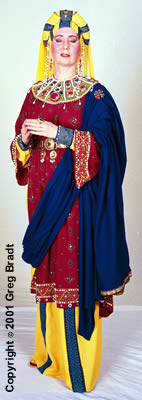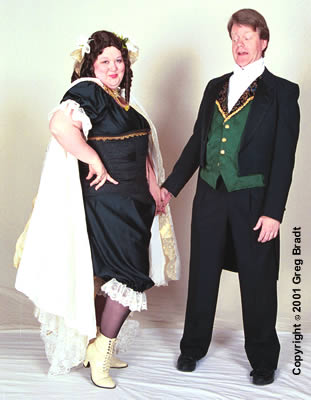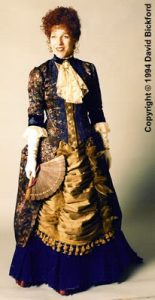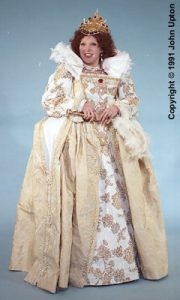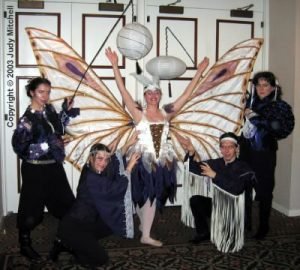CC19-OFFS-H-07: Victorian Fantasy
Competition Staff & Rules
Staff:
- Director: Pierre E. Pettinger, Jr.
- Master of Ceremonies: Darla Kruger
- Presentation Judges: Alison Kondo, D. Jeannette Holloman*, Wendy Bakgaard
Rules:
Competition is based on indirect competition. That is, each costume will be judged against what the judges see the award-winning standard to be. This means you will not be competing against anyone else – if there are two great costumes in a category, there will be two awards in that category. We care about dedication, application, and use of materials available. You do not have to beat anyone else.
How Do I Enter?
You must be attending Costume-Con 19 to enter the masquerade, likewise your model(s) if you are using any. Entry forms are available at Registration. I urge you to pre-register to avoid disappointment.
Judging:
The judging of the masquerade will be divided into three categories: Novice, Journeyman, and Master. Each entrant will be placed into a category according to experience. The presentation category decision will be made after we’ve had a brief discussion with you. A rough guide to the categories is as follows:
NOVICE:
A beginner with very little experience in costuming. Someone who has never earned money through costume or clothing, or studied costume or fashion at a tertiary level. Someone who has won no more than two awards at a previous similar event.
JOURNEYMAN:
A costumer of intermediate skill level. This includes students of costume and fashion at tertiary institutions, costume designers or makers working in amateur theatre. Any costumer who has won between three and six awards at previous similar events.
MASTER:
A costumer of advanced skills. This includes anyone who makes or who has in the past made more than fifty per cent of their income from fashion or costume. It also includes costumers who have successfully completed tertiary courses in fashion or costume, anyone who has won more than six awards at previous similar events, and Best in Show award winners at other Costumers’ Guild events.
Costumers who have won an award previously may not ‘step down’ a category this year.
Workmanship:
Another area of judging will be Workmanship. Workmanship judging is entirely voluntary; if you don’t want your seams examined, we won’t look! Workmanship judging will be done during the conference. The workmanship judge(s), separate from the other judges, will take a close look at your costume, its finish, detail, and care taken with construction. Workmanship awards are for exceptional accomplishment on the crafting of a costume, and the place where exquisite attention to detail will be recognised. The Workmanship awards have no bearing on the other masquerade awards.
Presentation Time Limits:
There will be a MAXIMUM TIME LIMIT on stage for each entry. These time limits depend upon how many people are in each entry.
1 person – 60 seconds
2 people – 60 seconds
3 people – 75 seconds
4 or more people – 90 seconds
Also note that these are MAXIMUM time limits, you don’t have to use all of the time allotted. Often, the-shorter-the-better is the way to go; you should remember that it only takes the human brain one eighth of a second to register visual input. Still, if you absolutely feel the time limit will ruin your presentation, contact the masquerade director to discuss your needs.
On The Day
The masquerade will begin on time. Entrants in the masquerade MUST be in the green room and checked in prior to this. The green room will be open to entrants earlier in the afternoon.
The green room will be fully equipped as a change room with make-up, mirrors, iron and ironing board, clothes racks, snacks, water, and an emergency repair table – the repair table is for emergency use only; do not try to build your costume on site!
When you arrive and check in at the front desk, you will be directed to a Den Parent whose job it is to help you avoid any problems, make sure there are enough helpers, and ensure you get a look at the stage before the audience is let in. For this reason alone we recommend you arrive as early as possible. Conference programming permitting, there will be rehearsal time during the afternoon. You will also have a chance to meet with the technical crew and the MC who will discuss the needs of your presentation.
We will have plenty of people back stage to help you with your costume, pass your tapes and special instructions along, to tell you when and where to go on stage, and to make sure you are ready. In short, we’ll do everything to make you comfortable, calm, and well taken care of.
GENERAL RULES
There are some restrictions upon masquerade entry, all of them for your own good:
1. No purchased or rented costumes may be shown in the Masquerade.
2. No live animals will be allowed in the Masquerade. This includes snakes, lizards, cats dogs, rats, ferrets, spiders, dinosaurs, birds, butterflies, etc. You’ll have to fake the fauna. For our purposes, guide dogs and other animals trained to assist the disabled are considered to be people and will be allowed.
3. Your costume must not be made or trimmed with any messy substances (The Peanut Butter Rule) that may ruin the costume of another entrant – the Turd Man who rubbed up against the Fairy Princess before an event some years ago has yet to be forgiven. You may not use anything wet, oily or dusty such as wet paint, powder or unfixed sparkle. The same goes for poorly-set or sticky colouring, and sharp, pointy or rough finishes that may become snagged.
4. No fire, no flame, no flashes, no firecrackers, no explosions, no exceptions. If you are carrying a weapon that needs to be fired, you will have to fake it with the aid of a sound and/or lighting effect.
5. Costumes with electric power requirements must be self-contained. We will not have extension cords draping over the stage.
6. There will be no microphones on the stage, however, you may tape dialogue with your music and mime, or you are welcome to give the MC a simple script to read before or during your act (remember, however, that the MC cannot be part of your act).
7. Your music/dialogue/effects must be recorded at the beginning of a blank cassette tape. On one occasion some years ago, an entrant used an old tape to record soundtrack for his dramatic presentation without erasing the original recording – as he exited the stage, there was a chorus of “Teenage Mutant Ninja Turtles”… Clearly label the right side of your tape with your name and the name of your entry and mark the other side with the words, “play other side”. Please cue your tape at the ready.
8. If you do not have specific lighting requirements, your entry will receive default lighting. This means the MC will announce your title whilst the stage is darkened, the lights will rise while you come on stage and will fade to black as you exit. More complicated arrangements can be made — please contact us if the entry form is not adequate for your descriptions.
9. If you plan to have any props on the stage, either before you enter or left after you exit, you may so long as they can be put down or picked up by stage hands in a single pass.
10. If you have weaponry as part of your costume, either real or fake, gun or knife, bat or sling, you must show your complete act to the masquerade director as a safety check before going on stage. Anyone not doing so will be instantly disqualified from the event. There are no prizes for accidentally (or purposefully) killing a judge.
11. If your costume is reproduced from a painting, book cover or favourite show, etc., please bring along a photocopy of your source for the judges to look at, likewise if you are making it from a description in a book. Otherwise, they may not understand what you are trying to achieve.
THIS IS A LOT OF INFORMATION. PLEASE DON’T LET IT WORRY YOU – TALK TO US INSTEAD. WE WILL MAKE EVERY ALLOWANCE POSSIBLE TO KEEP THINGS EASY.
If you absolutely/must/are dying to/can’t help but make a larger costume than we have doors for, let us know and we MAY be able to provide storage space in the wings. No guarantees this will be possible and it will be first-in-best-dressed (ahem).
WE RECOMMEND YOU TAKE NOTE OF THE STAGE and BACKSTAGE MAP AVAILABLE FROM THE CONCOM. The very nature of this show means you have a limited rehearsal. Walk it through and don’t panic — there will be plenty of well-trained helpers to gently guide you on and off stage so you only have to think about your presentation.
DOCUMENTATION:
* Each entry is required to have documentation.
* Keep your documentation to under 6 pages of readable text, and include the following: costume title, name and address of person responsible for entry, name(s) of designer(s) and creator(s), a brief identifying description, bibliography.
* No videos, computer files or slides, please. Do not submit original material; use photocopies.
* The basic requirements should include reference material that establishes the historical basis for your costume. This can be as minimal as a single picture with identifying caption, or it could be much more comprehensive. Your documentation may include the following: your own photographs of original historical garments and accessories; photocopies of visual sources used; pattern sources; rationale for design and choice of fabrics or colours; brief descriptions of any special tools or skills you used in construction; swatches.
CATEGORIES:
Historical Reproductions: A piece of living history, carefully documented and researched, patterned and created.
Historical Interpretations: Imaginative spin-offs based on a historical premise.
Movie Reproductions: Costumes made exactly the way they were made in the movie, including hairstyles, underwear worn by the actors at the time of production, etc.
FOR THOSE PLANNING ON WATCHING THE MASQUERADES, please note that we will not allow flash photography during a performance as it can temporarily blind an entrant, particularly one in an elaborate, limited-vision costume, as well as spoil any special lighting effect being used. All contestants will reappear, one-by-one, after the masquerade for a special photo call – a far better time to get flash photos while the judges are off tallying their ticks.
Miscellaneous Notes: Rules written by Christopher Ballis (original Director), replaced by Pierre E. Pettinger, Jr.
